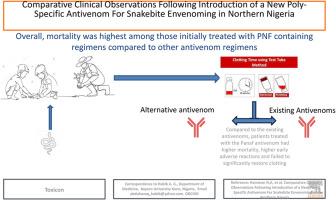在尼日利亚北部引入一种新的多价抗蛇毒血清治疗蛇咬伤后的比较临床观察
IF 2.4
4区 医学
Q2 PHARMACOLOGY & PHARMACY
引用次数: 0
摘要
抗蛇毒血清用于治疗蛇咬伤的有效性和安全性可以在体外、体内临床前和临床研究中进行评估。在这项研究中,我们评估了一种新推出的替代马衍生多价(AEP)抗蛇毒血清的临床效果。与现有的抗蛇毒血清相比,AEP抗蛇毒血清治疗的地毯毒蛇中毒合并凝血功能障碍患者死亡率更高,早期不良反应更频繁,凝血功能不能及时恢复。与现有的抗蛇毒血清相比,即使在逻辑回归模型中调整了潜在的混杂因素并将分析限制在接受最佳剂量的患者之后,AEP也未能防止凝血功能障碍患者的死亡。没有一种抗蛇毒血清能预防无凝血功能障碍患者的死亡。本文章由计算机程序翻译,如有差异,请以英文原文为准。

Comparative clinical observations following introduction of a new polyvalent antivenom for snakebite envenoming in northern Nigeria
The effectiveness and safety of antivenoms used for snakebite-envenoming can be evaluated in in-vitro, in-vivo preclinical and clinical studies. In this study, we evaluated the clinical effectiveness of a newly introduced Alternative Equine-derived Polyvalent (AEP) antivenom. Compared to the existing antivenoms, patients treated with the AEP antivenom showed higher mortality, more frequent early-adverse-reactions, and failure to restore clotting timely among carpet viper envenomed patients with coagulopathy. In contrast to existing antivenoms, the AEP failed to protect against deaths among patients with coagulopathy even after adjusting for potential confounders in a logistic regression model and restricting the analysis to patients who received optimal doses. None of the antivenoms protected against deaths among patients without coagulopathy.
求助全文
通过发布文献求助,成功后即可免费获取论文全文。
去求助
来源期刊

Toxicon
医学-毒理学
CiteScore
4.80
自引率
10.70%
发文量
358
审稿时长
68 days
期刊介绍:
Toxicon has an open access mirror Toxicon: X, sharing the same aims and scope, editorial team, submission system and rigorous peer review. An introductory offer Toxicon: X - full waiver of the Open Access fee.
Toxicon''s "aims and scope" are to publish:
-articles containing the results of original research on problems related to toxins derived from animals, plants and microorganisms
-papers on novel findings related to the chemical, pharmacological, toxicological, and immunological properties of natural toxins
-molecular biological studies of toxins and other genes from poisonous and venomous organisms that advance understanding of the role or function of toxins
-clinical observations on poisoning and envenoming where a new therapeutic principle has been proposed or a decidedly superior clinical result has been obtained.
-material on the use of toxins as tools in studying biological processes and material on subjects related to venom and antivenom problems.
-articles on the translational application of toxins, for example as drugs and insecticides
-epidemiological studies on envenoming or poisoning, so long as they highlight a previously unrecognised medical problem or provide insight into the prevention or medical treatment of envenoming or poisoning. Retrospective surveys of hospital records, especially those lacking species identification, will not be considered for publication. Properly designed prospective community-based surveys are strongly encouraged.
-articles describing well-known activities of venoms, such as antibacterial, anticancer, and analgesic activities of arachnid venoms, without any attempt to define the mechanism of action or purify the active component, will not be considered for publication in Toxicon.
-review articles on problems related to toxinology.
To encourage the exchange of ideas, sections of the journal may be devoted to Short Communications, Letters to the Editor and activities of the affiliated societies.
 求助内容:
求助内容: 应助结果提醒方式:
应助结果提醒方式:


